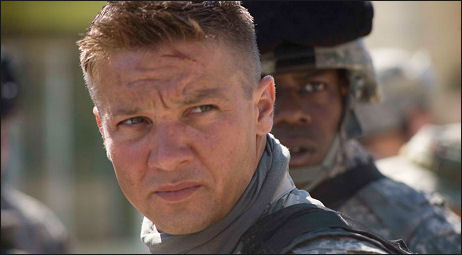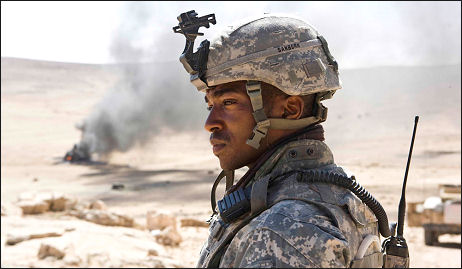Watching Kathryn Bigelow‘s The Hurt Locker is like having your heart operated on by a construction worker wielding a power pneumatic nail-driver. And the high-voltage stuff, which happens often, is, no joke, on the level of the armed creature-hunting and creature-evading sequences in Aliens, the classic 1986 thriller directed by Bigelow’s one-time-squeeze James Cameron. Where are the monsters, will they rise up and kill us when we round the next corner, and do we have a chance of killing them first? Except this time the monsters are just lying there, waiting to go fuck-you-bluh-doom!

Hurt Locker star Jeremy Renner
I had a couple of minor issues and confusions, one of them to do with the not-good-enough ending, another about the identity of a minor character who seems to die and then perhaps is alive later on. But you can’t sweat the small stuff.
Set in Baghdad and the full maelstrom of that godforsaken conflict, this is a full-power throttle, nail-biting, bomb-defusal suspense film that gradually becomes a kind of existential nerve ride about the risk and uncertainty of everything and anything, plus an explanation of the addiction that war is for some guys who go through it and can’t quite leave it alone.
The Hurt Locker is absolutely a classic war film in the tradition of Platoon, The Thin Red Line, Pork Chop Hill, Paths of Glory and the last 25% of Full Metal Jacket, and it damn well better be acquired by someone and set for release sometime between now and 12.31. Because I’m getting tired of this shit.
Something is very wrong with life, the world, human nature and the film business when a movie this knock-down good is still hunting for distribution. I’m obviously aware of all the Iraq War films that died last year but this movie is something else. You don’t shun movies like this. If you’re a distributor and that’s your judgment — walk away, we can’t sell it, we’ll lose our shirts — then you need to get out of the movie business and start selling refrigerators or cars. A buyer told me a little while ago that it only cost about $15 million or less. How could the numbers not work?

This is a huge bounce-back for Bigelow, whose career has been on a low-flame for the last five or six years despite the fine, tight chops she showed on K-19: The Widowmaker (2002) and The Weight of Water (’00). This is unquestionably her best film ever. It’s also a great boon for Jeremy Renner, who plays the lead role Staff Sergeant William James, a bomb-defusing risk junkie. It’s a solid plus for costars Anthony Mackie and Brian Gerahty, and an occasion for three strong cameos by Guy Pearce, Ralph Fiennes and David Morse.
There is no “wrong” or “right” judgement about any film, but now that I’ve seen The Hurt Locker I’m stunned that Variety‘s Derek Elley could have panned it the way he did, calling it a hellish thing to sit through, and one that says nothing new about the Iraq War U.S. troop experience, and that it takes too long to get to the point (such as it is). What did Elley see over there? Was he on painkillers?
Mark Boal‘s screenplay is based on his first-hand experience with with a bomb squad in Baghdad sometime in ’04 or ’05. I loved that it doesn’t tell a carefully structured story with some kind of problem that has to solved or catharsis built into the third act. What it is, mainly, is a kind of you-are-there docudrama — feel it or run from it but this is what’s it really like, hombre.
There are something like six or seven action-suspense scenes, but what moves it along, simply, is character. Renner’s risk addiction, Mackie’s alarm at this tendency (and then his gradual acceptance and even submission), Gerahty’s shock and horror at what he encounters almost every day.

Hurt Locker costar Anthony Mackie
The movie starts to get classically emotional a little less than hour in when Renner becomes friendly with a young Arab kid named “Beckham” (Christopher Sayegh). The next beat in this bond shifts into a dark and tragic gear about 25 or 30 minutes later.
I don’t want to reveal too much here, but the only thing that didn’t feel quite right was a close-to-the-end sequence when Renner goes home to his (divorced?) wife and kid, and right away we can spot the familiar syndrome of the war veteran who can’t quite settle down and groove with a midle-class, comforts-of-home lifestyle. I don’t want to register a major complaint about this; it doesn’t work against the film as much as it fails to add anything significant.
This is probably the best film I’ve seen at the Toronto Film Festival so far. And to see it I had to blow off my last shot at seeing The Wrestler as well as a 12 noon press screening of I’ve Loved You For So Long, which I’ll at least be able to catch tomorrow night. But no Wrestler, dammit! Sorry, Darren Aronofsky, for this twist of fate. Hoping to see it very soon back in Los Angeles.












